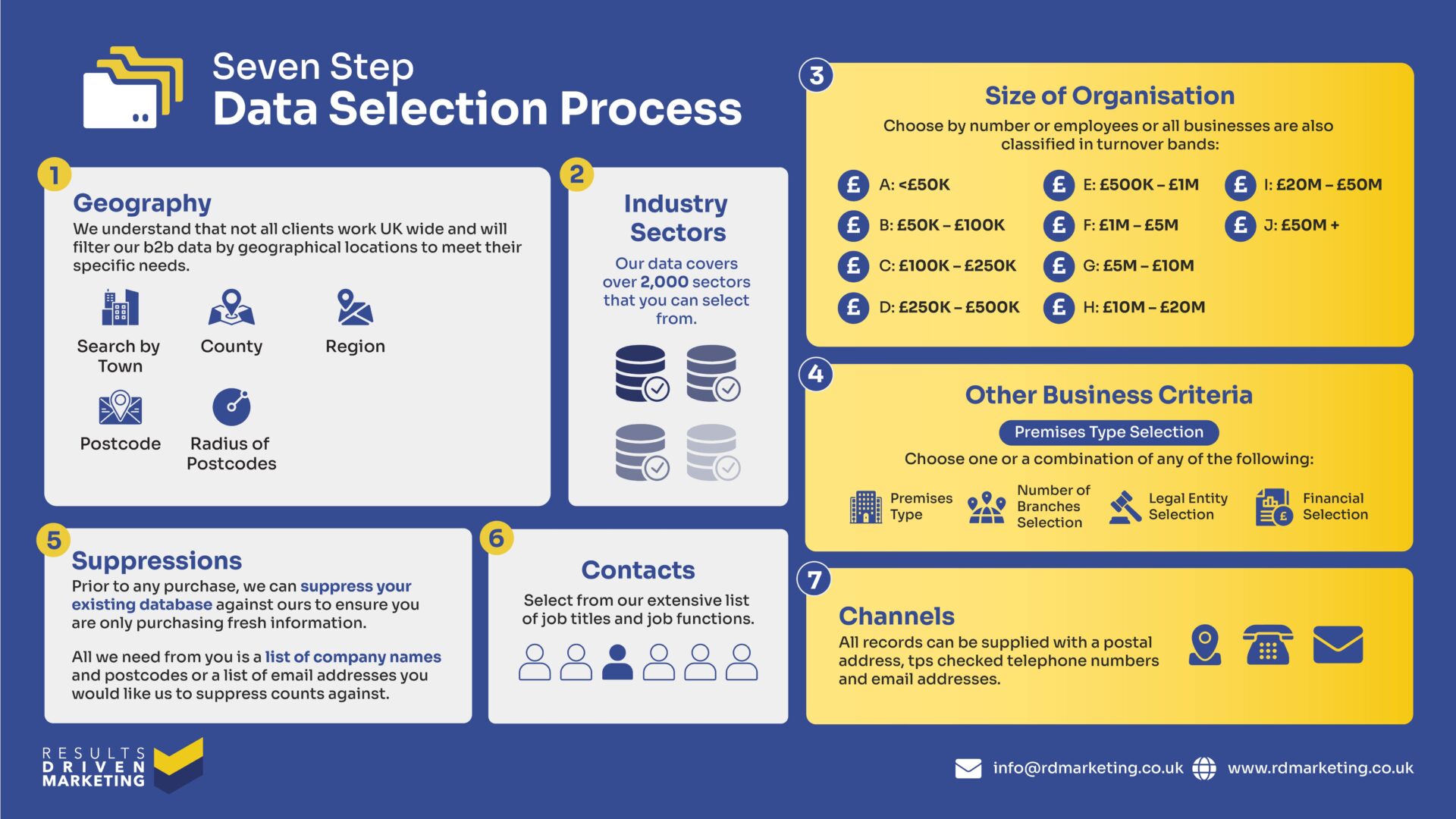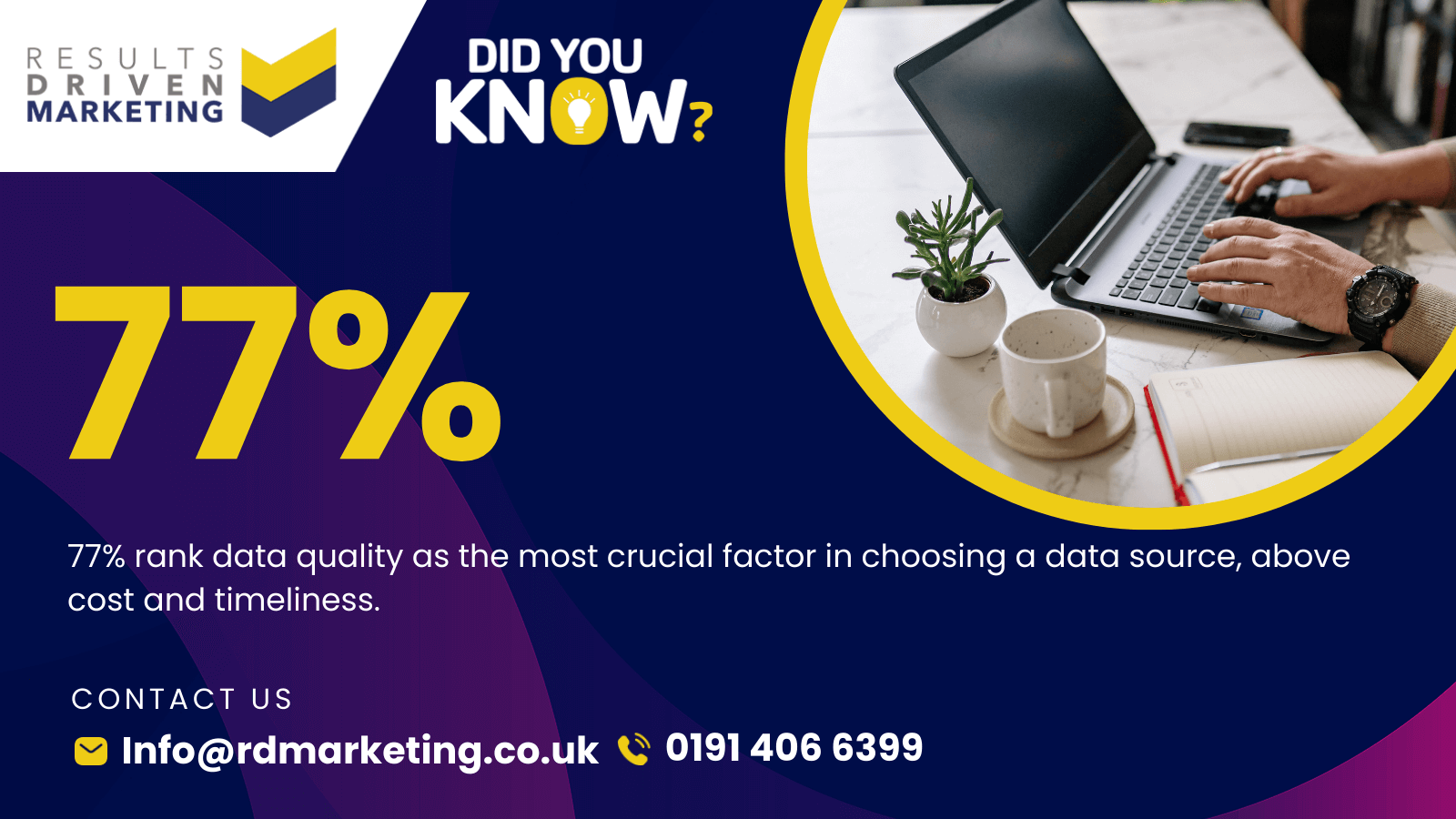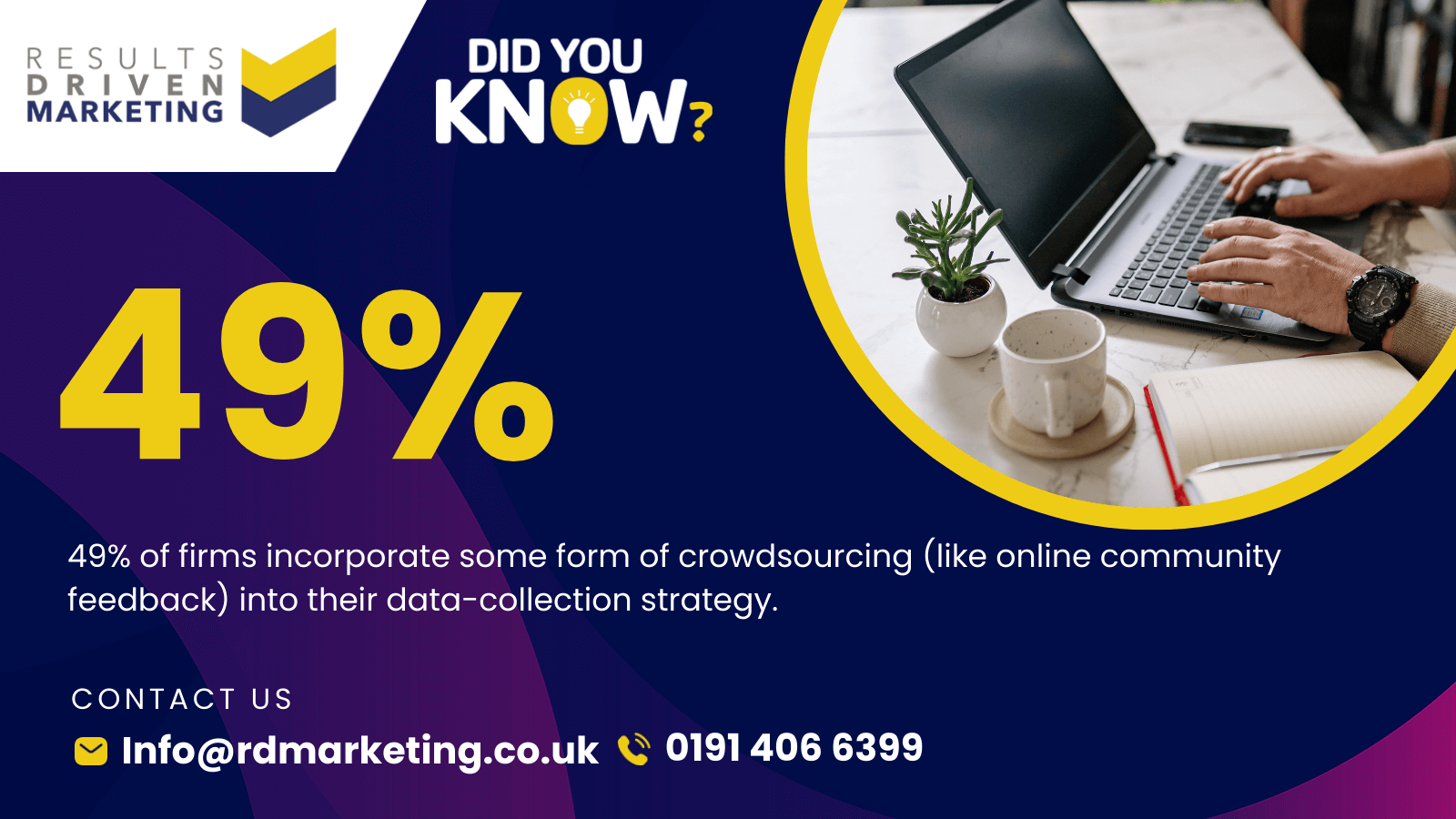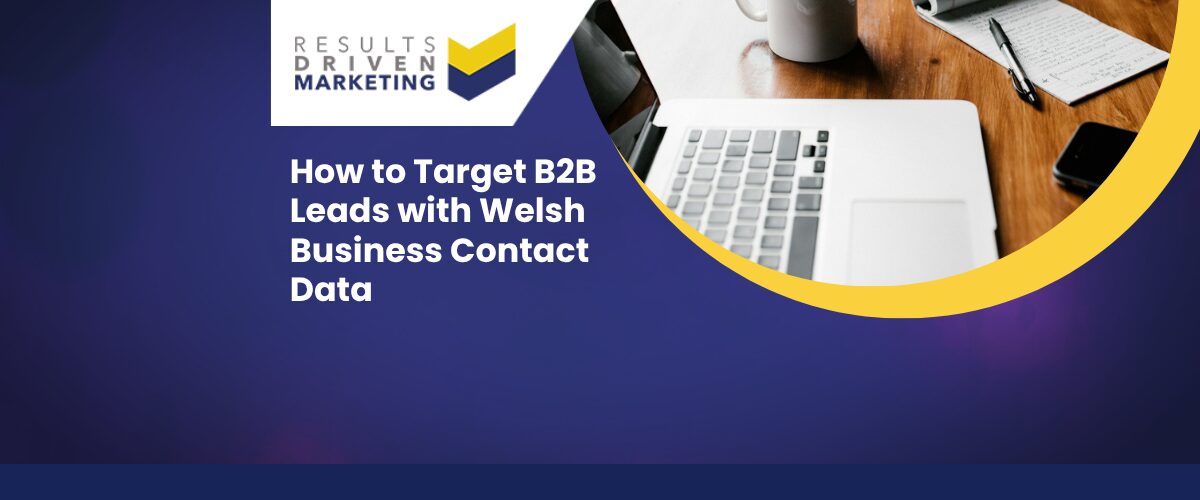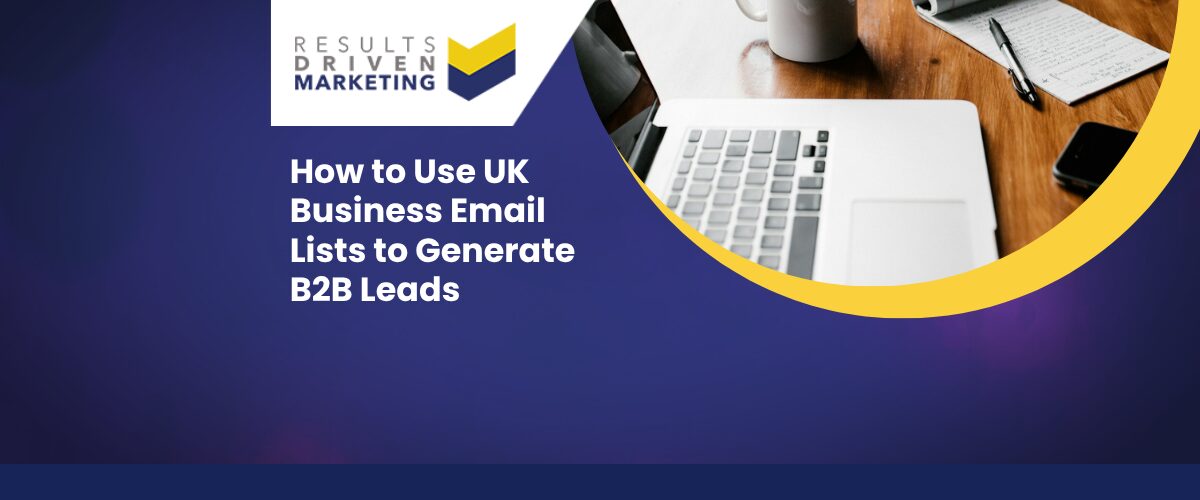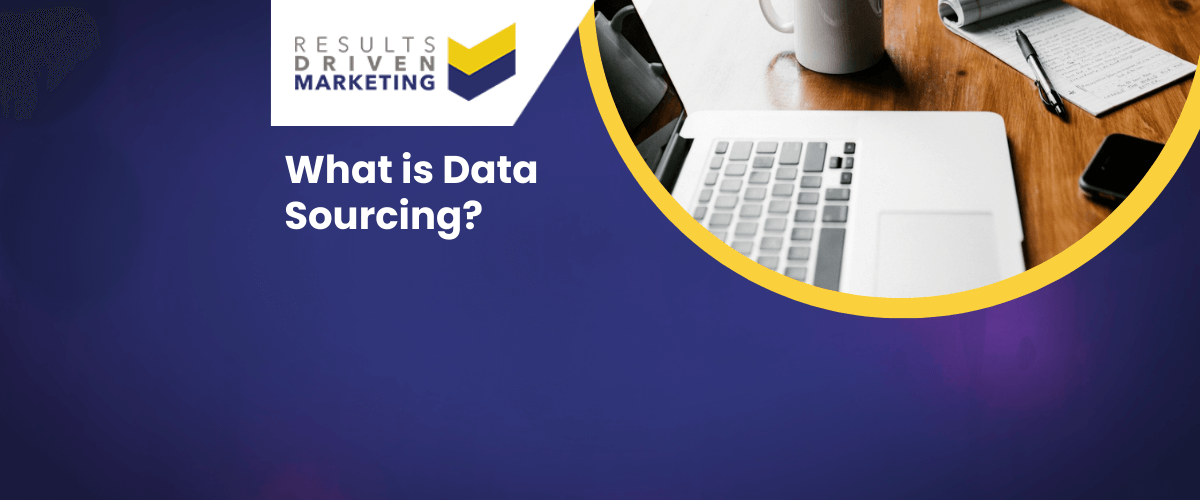
What is Data Sourcing?
The sourcing of information, often called data sourcing, is all about collecting, verifying, and organising raw details from countless channels to power business intelligence, analytics, and marketing efforts.
Companies need dependable, up-to-the-minute data to keep their marketing strategies agile, their internal processes streamlined, and their competitive edge sharp. Whether you’re assembling customer profiles or scoping out your target audience, data sourcing matters because it’s the foundation for truly reliable and actionable conclusions.
At RD Marketing, we believe that effective sourcing of information can propel organisations forward. For instance, some businesses benefit tremendously from specialised B2B Data solutions when trying to target specific company segments.
Others may find that direct mail campaigns continue to yield great results, which is why Direct Mail Data can be incredibly valuable. Meanwhile, companies reaching customers by phone might prefer Telemarketing Data to enhance outbound call strategies.
Table of contents:
What is Data Sourcing?
So, what exactly is data sourcing? In tech-savvy circles, it’s the systematic approach to finding and managing data from a plethora of sources. But let’s break it down: imagine you’re a chef, and your signature dish is as good as the ingredients you pick.
Data sourcing is akin to selecting the freshest, most flavorful produce to whip up a culinary masterpiece. It’s about sifting through the noise to find the data that will truly make your business strategies sizzle.
Why Is the Sourcing of Information Important?
The sourcing of information is so much more than just a simple step in a marketing or analytics workflow—it’s the backbone of any effective decision-making process.
Let’s break down why this really matters:
Strategic Value of High-Quality Data
-
- Solid data that has been reliably gathered and verified lends weight to your actions. Think about how you can use the sourcing of information to understand what your customers truly want, or to pinpoint gaps in your product offerings.
- It can mean the difference between investing in a marketing campaign that hits all the right notes—or one that leaves you scratching your head at poor returns.
Implications of Poor Data Sourcing
-
- Financial Risks: If you invest in the wrong market or funnel budgets into ineffective outreach, the financial repercussions can stack up quickly.
- Reputational Damage: Bad information can push out misleading content, unsubstantiated claims, or irrelevant offers. Over time, customers lose trust and loyalty.
- Compliance Issues: Incorrectly sourced data might clash with privacy regulations or industry standards. This can lead to hefty fines and a tarnished brand image. Using verified channels like Direct Mail Data helps maintain compliance while still reaching potential customers in a meaningful way.
Data-Driven Decision-Making
-
- Organisations thrive when decisions are made on real-world metrics rather than guesswork. And this is exactly where the sourcing of information becomes a true game-changer.
- When your data is reliable, you can forecast trends, set more effective goals, and adapt quickly to shifting consumer behaviors.
Upholding Sourcing Integrity
-
- Double-checking your raw information isn’t just about a sense of thoroughness; it’s about ensuring the entire organization can trust the analytics that follow.
- A strong foundation of data quality translates directly to operational success. When the underlying figures, insights, and metrics are correct, the road to making strategic, data-driven choices becomes a lot clearer.
If you’d like more information on how to strengthen your own data workflows, or if you’re curious about best-in-class strategies, head over to RD Marketing for insights and guidance that align perfectly with your unique objectives.
Perspectives of Data Sourcing
Now, let’s dive a bit deeper and look at data sourcing from two distinct vantage points: content-driven and commercially-driven.
It’s like comparing two different breeds of the same animal – both part of the same kingdom but adapted to thrive in different environments.
-
Content-Driven Data Sourcing:
- Focuses on the richness and relevance of information.
- Often driven by academic, research, or informational needs.
- Prioritises depth and accuracy of data over volume.
- Examples include scholarly articles, detailed reports, and comprehensive studies.
-
Commercially-Driven Data Sourcing:
- Targets data that can directly influence business decisions and profits.
- Emphasises speed, efficiency, and actionable insights.
- Volume and variety of data are often key to identifying trends and patterns.
- Examples span market research data, customer behavior analytics, and sales figures.
Data Sets and Catalogs
In the realm of data sourcing, data sets, and catalogs are the maps and compasses guiding businesses to their treasure – actionable insights. Here’s how they’re utilised:
-
Data Sets:
- Collections of related data points, meticulously organised for specific analysis.
- Used to identify trends, forecast outcomes, and drive machine learning models.
- Example: A retailer analysing a data set of customer purchases to tailor marketing strategies.
-
Data Catalogs:
- Inventories of data assets within an organisation, designed for easy navigation and understanding.
- Facilitate collaboration and compliance, ensuring everyone’s singing from the same hymn sheet.
- Example: A healthcare provider maintains a catalog of patient data to improve care and manage records.
Creating a Data Catalog: A Step-by-Step Approach
Inventory Your Data Assets: Gather all your data sources and document them.
Categorise and Classify: Organise your data into logical categories.
Implement Governance Standards: Define who can access what and how data is to be used.
Ensure Data Quality: Regularly clean and update your data to maintain its integrity.
Make It User-Friendly: Design your catalog with the end-user in mind for ease of use.
Cost Drivers in Data Sourcing
The financial aspect of data sourcing can be as layered as an onion, with each layer representing a different cost factor. Let’s peel back these layers:
- Acquisition Costs: The upfront fees for accessing proprietary databases or purchasing datasets.
- Technology Costs: Investments in software and hardware to process and store data.
- Labor Costs: The human expertise required to gather, clean, and analyse data.
- Maintenance Costs: Ongoing expenses to update and manage data sources.
Managing Costs Effectively:
- Leverage Open Source Tools: Where possible, use free tools and platforms to reduce technology costs.
- Outsource Wisely: Consider outsourcing to manage labor costs, but choose partners who value quality and efficiency.
- Regular Audits: Conduct frequent audits to ensure you’re only paying for the data you need and use.
Types of Data Sources
When it comes to the sourcing of information, understanding where your data originates is essential. Different types of data sources can influence not just the quantity of information you gather, but also its quality and relevance to your organisation’s goals.
Primary Sources
Primary sources are all about original, first-hand information you collect yourself. This could involve:
- Surveys: Perhaps you’re sending questionnaires directly to potential customers or existing clients. This raw data can help guide a brand’s outreach strategy or even influence which Telemarketing Data you decide to invest in for your campaigns.
- Experiments: Conducting controlled tests to see how a particular product or service performs in various conditions.
- Direct Observations: Observing consumer behavior in real time, whether it’s through on-site retail tracking or digital analytics.
Secondary Sources
Secondary sources, meanwhile, revolve around information that already exists out there in the world. These may include:
- Public Databases and Government Statistics: Sometimes you’ll find gold in readily available datasets compiled by official institutions.
- Research Studies and Industry Reports: Academia, think tanks, or market research firms generate tons of insights you can leverage.
- Precompiled Lists: Providers like B2B Data specialists can deliver curated lists of potential leads, removing some of the guesswork in your outreach.
Internal vs. External Sources
-
- Internal Sources: Data generated within your own organisation—think sales records, customer support logs, marketing analytics, or HR data. This route often reveals patterns and trends specific to your operational performance.
- External Sources: Data you acquire from third parties, such as public websites, partners, or specialized data vendors. Harnessing an International Email List can expand your reach globally.
Balancing these different options is part of the art and science of sourcing of information. Organizations that skillfully integrate internal insights with trustworthy external sources generally end up with an information pipeline that’s both comprehensive and nuanced.
Data Governance
Steering the ship of data sourcing requires a sturdy rudder, and that’s where data governance comes in. It’s the compass that guides you through the choppy waters of data management.
Principles of Data Governance:
- Integrity: Ensuring the accuracy and consistency of data across the board.
- Security: Protecting data from unauthorised access and breaches.
- Quality: Maintaining high standards of data quality for reliable analysis.
- Compliance: Adhering to laws and regulations governing data usage.
Data Governance Checklist:
- Establish clear data policies and procedures.
- Assign data stewards and governance teams.
- Implement robust data security measures.
- Regularly review and update data governance strategies.
What is Big Data?
Big data is not just a buzzword; it’s the Everest of the data world—massive, formidable, and waiting to be conquered.
Big Data Demystified:
- Volume: The sheer quantity of data generated every second.
- Velocity: The rapid rate at which data flows in from various sources.
- Variety: The wide array of data types and formats available.
Implications for Data Sourcing:
- Big data expands the horizons of data sourcing, offering a panoramic view of information.
- It demands robust infrastructure and sophisticated tools to harness its full potential.
Visualising Big Data Growth:
- Imagine a graph where the x-axis represents time and the y-axis represents data volume.
- The line on the graph climbs steeply, reflecting the exponential surge in data generation.
Generative AI
As we tiptoe into the brave new world of generative AI, it’s like we’re opening a door to a room filled with possibilities.
This isn’t just any room; it’s one where the walls are lined with the most advanced algorithms, capable of creating and curating data like never before.
- The Impact: Generative AI is shaking up the data-sourcing scene, bringing a fresh perspective to the table. It’s like having a new player in the game who knows a few tricks we’ve never seen.
- The Potential: Imagine having the ability to generate datasets on-the-fly, tailored to your specific needs. Generative AI stands ready to revolutionise our approach to data, making it more dynamic, more responsive, and frankly, more exciting.
Data Sourcing Checklist
Ready to dive into data sourcing? Here’s a step-by-step guide to ensure you’re not just dipping your toes in but making a splash:
Identify Your Data Needs: Start by pinpointing exactly what data will drive your business forward.
Source Selection: Choose your data sources wisely, like picking the right ingredients for a gourmet meal.
Quality Check: Ensure the data’s accuracy and relevance—it’s the backbone of your decision-making, after all.
Data Integration: Seamlessly blend the new data into your existing systems, like a DJ mixing tracks.
Regular Updates: Keep your data fresh and up-to-date, because stale data is about as useful as yesterday’s news.
Advantages and Disadvantages of Data Sourcing
Let’s lay it all out on the table, shall we? Data sourcing, like any strategy, comes with its bouquet of roses and its occasional thorns.
-
Advantages:
- Informed Decisions: With data at your fingertips, you’re making choices based on insight, not just instinct.
- Competitive Edge: It’s the secret sauce that gives your business the zing to stand out in a crowded market.
-
Disadvantages:
- Overwhelm: Sometimes, it’s like drinking from a firehose—too much data can be as tricky as too little.
- Costs: Quality data doesn’t always come cheap, and let’s not even start on the potential hidden costs.
Is Using Data Sourcing a Good Idea?
So, you’re pondering whether to jump on the data-sourcing bandwagon? Let’s chat about that. It’s not a one-size-fits-all answer, but here’s the deal:
- Context Matters: Your business is unique, and so are your data needs. What works for one might not work for another.
- Assessment Time: Take a good, hard look at your business objectives, resources, and capabilities. Does data sourcing align with where you’re headed?
By weighing these considerations, you’ll be in a better position to decide if data sourcing is your golden ticket or if you’re better off without it.
Key Considerations of Using Data Sourcing
When you’re ready to take the plunge into the data sourcing pool, it’s not just about jumping in. It’s about knowing the depth, the temperature, and what tools you need to swim successfully. Here’s a quick rundown of what to keep in mind:
- Data Relevance: Is the data you’re eyeing up actually going to give your business the insights it needs? It’s like choosing the right key for the right lock.
- Data Quality: You want data that’s as clean and sharp as a chef’s knife—anything less, and you’re not slicing through the competition.
- Data Compliance: Stay on the right side of regulations. It’s a tightrope walk, but one you can’t afford to slip up on.
- Cost vs. Value: Weigh the gold you’ll spend against the gold you’ll mine. Is the data worth its weight in your business treasure chest?
- Timeliness: In the world of data, timing is everything. Are you catching the wave at the right moment?
Challenges in the Sourcing of Information
Let’s be honest—while the sourcing of information is incredibly valuable, it’s far from simple. Whether you’re collecting data for marketing, analytics, sales, or research, there are a number of frustrating challenges you’ll inevitably run into. And trust us, if you’re not actively managing these issues, they will affect the accuracy, reliability, and ultimately, the performance of your data-driven campaigns.
Here’s a breakdown of the biggest obstacles you need to look out for when sourcing data.
Data Accuracy and Reliability
Ever found yourself working with a spreadsheet full of names, emails, and numbers that looked perfect… but half of it turned out to be useless? Yep, that’s the reality when data accuracy isn’t prioritised.
Some of the most common culprits behind inaccurate information include:
-
Outdated records (especially in fast-moving industries)
-
Typos, formatting inconsistencies, or duplicate entries
-
Incorrect manual inputs from original sources
-
Poor data validation processes at the point of capture
When you’re dealing with large datasets—whether it’s for telemarketing, email outreach, or direct mail—accuracy is everything. It affects delivery rates, response rates, and even your brand’s credibility.
If you’re buying B2B data, make sure you’re sourcing it from reliable, verified providers. For instance, at RD Marketing, we go the extra mile to ensure our data is clean, accurate, and up to date. Our Data Cleansing Services are also a smart way to correct and enhance your existing records if you’re not starting from scratch.
Data Freshness and Timeliness
Here’s the thing: even accurate data becomes irrelevant if it’s not timely. The sourcing of information needs to be consistent and ongoing—otherwise, what you’re working with is already old news.
Why does freshness matter?
-
Contact details change (especially with job switches and company restructures)
-
Business needs evolve rapidly
-
Markets shift, and outdated information leads to missed opportunities
A marketing list from 6 months ago might already have a significant chunk of obsolete records. That’s why many businesses prefer solutions like our Email Address List Data, which are continually updated to ensure real-time accuracy and engagement potential.
If you’re relying on cold outreach, lead generation, or customer insights, working with stale data is basically like shouting into the void.
Compliance (GDPR, CCPA)
Let’s talk about the elephant in the room: compliance.
With strict data protection regulations like GDPR in the UK/EU and CCPA in the US, businesses can’t afford to cut corners. The rules around how you collect, process, and use personal data are tighter than ever—and breaching them can lead to heavy fines or worse, reputational damage.
When it comes to the sourcing of information, this means:
-
You must have a lawful basis for data processing
-
Individuals should be aware their data is being used
-
You need to provide opt-out options and respect privacy preferences
-
Data must be securely stored and protected
To stay compliant, it’s crucial to work with data suppliers who understand the legal landscape. Our CTPS Checker helps businesses stay compliant with telephone preference services, ensuring you don’t accidentally call someone who’s opted out.
Pro tip: Always double-check the data provider’s compliance policies before making a purchase.
Cost and Accessibility
Another hurdle in the sourcing of information? Budget and availability. While good data isn’t cheap, bad data is far more expensive in the long run.
Here’s why cost becomes a roadblock:
-
High-quality B2B or consumer data lists often come with a price tag
-
Licensing agreements or subscriptions may limit usage
-
Some niche datasets are only available through specific vendors or industry sources
That said, you don’t need to overspend to get high-quality information. At RD Marketing, we offer flexible pricing options to match your budget and business goals—whether you’re after International Email Lists, Direct Mail Data, or niche Telemarketing Data.
Remember: investing in the right data now can reduce marketing waste and increase ROI later.
Ethical Concerns
Last but definitely not least—ethics.
Just because data is available doesn’t mean it’s ethical to use. One of the murkier areas in the sourcing of information involves how that data was originally collected, and whether individuals actually consented to their data being shared or sold.
Some key ethical questions to ask:
-
Was the data collected transparently?
-
Did individuals give informed consent?
-
Is it being used in a way that respects their privacy?
If you’re building long-term trust with your audience, ethical sourcing isn’t just “nice to have”—it’s essential. At RD Marketing, we’re big believers in ethical data practices. Every list we supply is GDPR-compliant, and we help clients enrich and enhance their data responsibly with our Data Enrichment Services.
Alternatives to Using Data Sourcing
Now, let’s talk about the road less traveled. What if traditional data sourcing isn’t your path? Well, there are other routes on the map:
- Crowdsourcing: It’s like throwing a net out to the world and seeing what wisdom you can catch.
- Internal Data Mining: Sometimes, the treasure you seek is buried in your own backyard. Dig into your existing data for hidden gems.
- Public Data Sets: There’s a wealth of data out there, free for the taking. It’s like foraging in the forest of the internet—just be sure to pick the right berries.
Each of these paths has its own set of signposts and pitfalls. Choose the one that leads to your business utopia.
FAQ
Got questions? You’re not alone. Here are the answers to those burning queries that keep you up at night:
What’s the Real Deal with Data Sourcing?
Think of data sourcing as your business’s GPS. It’s guiding you through the wild terrain of the market landscape, helping you avoid pitfalls and find the best route to success.
How Can I Ensure Data Quality?
Quality control in data is like having a bouncer at the door of your club. You only want the best inside. Implement rigorous checks and balances to keep the data clean and useful.
Is There a Way to Source Data Cost-Effectively?
Absolutely. It’s all about being a savvy shopper. Look for deals, negotiate, and always measure the ROI. Remember, expensive doesn’t always mean better.
Can Small Businesses Benefit from Data Sourcing?
Small businesses can dance with the big players when it comes to data sourcing. It’s all about smart, strategic plays. Use data to punch above your weight class.
Who are we?
Thinking about “how do I buy data“?
Providing b2b database solutions is our passion.
Offering a consultancy service prior to purchase, our advisors always aim to supply a database that meets your specific marketing needs, exactly.
We also supply email marketing solutions with our email marketing platform and email automation software.
Results Driven Marketing have the best data of email lists for your networking solutions as well as direct mailing lists & telemarketing data in telemarketing lists
We provide data cleansing and data enrichment services to make sure you get the best data quality.
We provide email marketing lists and an international email list for your business needs.
At RDM We provide b2c data as we have connections with the best b2c data brokers.
A good quality b2b database is the heartbeat of any direct marketing campaign…
It makes sense to ensure you have access to the best!
Call us today on 0191 406 6399 to discuss your specific needs.
Results Driven Marketing
0191 406 6399


